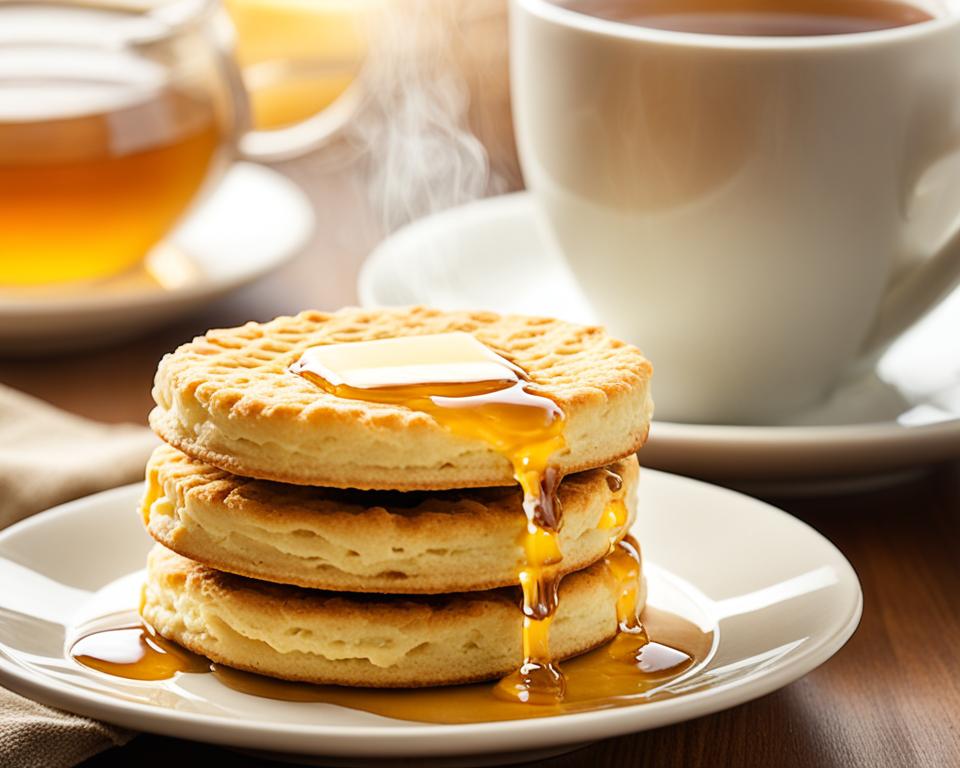Welcome to our delicious and easy biscuit recipe! In this article, we will guide you through the process of making homemade flaky biscuits that are sure to leave you craving for more. With their buttery and flaky texture, these biscuits are the perfect addition to any meal or snack time.
There’s something so comforting about the aroma of freshly baked biscuits. Whether you’re a seasoned baker or a beginner in the kitchen, this recipe is incredibly straightforward and yields impressive results. In just a few simple steps, you’ll have a plate of golden brown, mouthwatering biscuits ready to be devoured.
So, grab your biscuit dough cutter and let’s get started on this delectable journey!
Key Takeaways:
- With a buttery and flaky texture, these homemade biscuits are a delightful treat.
- This easy biscuit recipe has been passed down through generations, ensuring its perfection.
- No special techniques or methods are required to make these fluffy and golden brown biscuits.
- The key ingredients include all-purpose flour, baking powder, salt, butter, and milk, with variations and substitutions available for experimentation.
- Follow the step-by-step instructions to achieve the perfect biscuits every time, and keep these troubleshooting tips in mind for any issues that may arise.
Why You’ll Love These Biscuits
If you’re looking for a delicious and versatile treat, these flaky biscuits are just what you need. With their easy biscuit recipe and homemade goodness, they are sure to become a family favorite. Here are a few reasons why you’ll love these biscuits:
They’re Incredibly Easy to Make
No need to worry about complicated techniques or methods. Making these biscuits is a breeze. Simply gather the ingredients, mix them together, roll out the dough, and bake. It’s that simple! Whether you’re a seasoned baker or a novice in the kitchen, you’ll find this recipe easy to follow and achieve mouthwatering results.
They Come Out Fluffy and Flaky
When you bite into one of these biscuits, you’ll be greeted by a fluffy and delicate texture. The combination of ingredients and the baking process result in a biscuit that is light and airy. Each bite is a delightful experience, and you won’t be able to resist indulging in more.
They Have a Beautiful Golden Brown Color
Aesthetics matter, and these biscuits deliver on that front too. As they bake, the biscuits turn a golden brown color that is visually appealing and enhances their overall appeal. Not only do they taste fantastic, but they also look inviting and tempting.
They’re Perfect Anytime, Anywhere
These biscuits are versatile and can be enjoyed in a variety of ways. Have them for breakfast with a dollop of butter and jam, or serve them alongside a hearty meal. They also make a great base for biscuit sandwiches or can be paired with soups and stews. However you choose to enjoy them, these biscuits are a winner.
So what are you waiting for? Gather the ingredients and get ready to enjoy these flaky biscuits.
Stay tuned for our upcoming sections where we will share the ingredients and substitutions, step-by-step instructions, tips for perfect biscuits, and more.
Ingredients and Substitutions
When it comes to making these flaky biscuits, the key ingredients you’ll need are all-purpose flour, baking powder, salt, unsalted butter, and milk. However, don’t be afraid to get creative and try out different substitutions and variations to customize the recipe to your liking.
Substitutions
If you’re looking to switch things up and experiment with different flavors and textures, here are some ingredient substitutions you can try:
- Self-Rising Flour: Instead of using all-purpose flour, you can use self-rising flour. This type of flour already contains baking powder and salt, so you can omit those from the recipe.
- Buttermilk: For a tangier flavor, swap out regular milk with buttermilk. It will not only add a subtle tang but also contribute to the tender texture of the biscuits.
- Alternative Butters: While the recipe calls for unsalted butter, you can experiment with different types of butter, such as salted butter or flavored butter, to add a unique twist to your biscuits.
- Add-Ins: Don’t hesitate to incorporate your favorite ingredients into the biscuit dough. Options like shredded cheese, herbs, or even cooked bacon can add extra flavor and dimension to your biscuits.
Remember, these substitutions are just suggestions, and you can mix and match to create your own signature biscuit variation.
Biscuit Ingredient Substitutions and Variations
| Ingredient | Substitution/Variation |
|---|---|
| All-Purpose Flour | Self-Rising Flour |
| Milk | Buttermilk |
| Unsalted Butter | Salted Butter, Flavored Butter |
| Shredded Cheese, Herbs, Cooked Bacon |
As you can see, there are plenty of ways to experiment and tailor the biscuit recipe to your preferences. Don’t be afraid to get creative and have fun in the kitchen!
Step-By-Step Instructions
To create these delicious flaky biscuits, follow these simple step-by-step instructions:
- Preheat the oven: Begin by preheating your oven to 450°F (230°C). This ensures that your biscuits will bake to perfection.
- Combine the dry ingredients: In a large mixing bowl, combine 2 cups of all-purpose flour, 1 tablespoon of baking powder, and 1/2 teaspoon of salt. Mix well to ensure even distribution of the ingredients.
- Cut in the butter: Cut 6 tablespoons of cold unsalted butter into small cubes. Using a pastry cutter or your fingertips, cut the butter into the dry ingredients until the mixture resembles coarse crumbs.
- Add the milk: Slowly pour in 3/4 cup of cold milk into the dry mixture. Stir gently with a wooden spoon or rubber spatula until the dough starts to come together. Be careful not to overmix.
- Roll out the dough: Transfer the dough onto a lightly floured surface. With floured hands, gently knead the dough a few times until it becomes smooth. Then, using a rolling pin, roll the dough out to about 1/2 inch (1.3 cm) thickness.
- Cut out the biscuits: Using a round biscuit cutter or a glass, cut out biscuits from the rolled-out dough. Press the cutter straight down without twisting to ensure even rising.
- Place on a baking sheet: Arrange the cut biscuits on a baking sheet lined with parchment paper. Leave a small gap between each biscuit to allow for even baking.
- Bake until golden brown: Place the baking sheet in the preheated oven and bake the biscuits for 12-15 minutes, or until they turn golden brown on top.
Tips for Perfect Biscuits
When it comes to making biscuits, following a few tips can make all the difference in achieving the perfect batch. These tips will help you handle the dough correctly, avoid overmixing, and ensure that your biscuits rise beautifully.
Avoid Overmixing the Dough
One common mistake when making biscuits is overmixing the dough. While it’s important to combine the ingredients thoroughly, excessive mixing can lead to tough and dense biscuits. To avoid this, mix the dough just until the ingredients come together. It’s okay if there are a few small lumps of butter remaining in the dough—they will contribute to the flakiness of the final product.
Handle the Dough with Care
When handling biscuit dough, it’s crucial to be gentle and avoid excessive handling. The heat from your hands can quickly melt the butter in the dough, resulting in flatter biscuits. To prevent this, handle the dough as little as possible. Use a light touch when shaping and transferring the biscuits to the baking sheet. This will help maintain the integrity of the cold butter, which creates those perfect flaky layers.
Use Fresh Baking Powder
The freshness of your baking powder plays a crucial role in the rise and fluffiness of your biscuits. Over time, baking powder can lose its potency, resulting in biscuits that may not rise as much as desired. To ensure optimal results, always check the expiration date of your baking powder and use a fresh batch. This will give your biscuits the lift they need for a light and airy texture.
By following these simple tips, you’ll be well on your way to baking the most delectable biscuits. Remember to avoid overmixing, handle the dough gently, and use fresh baking powder for the best results. With these techniques, you’ll achieve biscuits that are tender, flaky, and simply irresistible.
The History of Biscuits
Biscuits have a rich history and have evolved over time. They originated from a simple hardtack biscuit made from flour and water. Over the years, the recipe evolved to include salt, butter, milk, and leavening agents like baking powder. Southern cooks are known for their expertise in making biscuits, and their use of soft winter wheat flour contributes to their fluffy texture.
Serving Suggestions
These flaky biscuits are incredibly versatile and can be enjoyed in many ways. Whether you prefer them on their own or paired with various accompaniments, there are plenty of delicious serving options to explore.
Biscuits and Gravy
One classic way to enjoy these flaky biscuits is with a generous serving of biscuits and gravy. The creamy savory gravy pairs perfectly with the buttery and tender biscuits, creating a comfort food combination that is hard to resist. It’s a popular choice for breakfast or brunch, but can be enjoyed any time of the day.
Biscuit Sandwiches
Another delightful option is to use these biscuits as a base for delicious sandwiches. The flaky and substantial texture of the biscuits provides a sturdy foundation for various fillings. You can get creative and build your own biscuit sandwiches with ingredients like crispy bacon, scrambled eggs, avocado, or even fried chicken. The possibilities are endless, making it a versatile and satisfying meal option.
Biscuits with Soup
These flaky biscuits also make a great accompaniment to soups and stews. The buttery flavor and fluffy texture complement the warm and comforting nature of a bowl of soup. Whether you prefer a classic chicken noodle soup or a hearty beef stew, serving a biscuit on the side adds a delightful touch and makes it a complete and satisfying meal.
No matter how you choose to enjoy them, these flaky biscuits are guaranteed to elevate your dining experience. Try out different combinations, get creative with your fillings, and savor each delicious bite.
| Other Serving Suggestions |
|---|
| Biscuits with butter and jam |
| Biscuits with honey |
| Biscuits with sausage and eggs |
| Biscuits with sliced ham and cheese |
| Biscuits with pulled pork |
Flaky Biscuit Variations
If you want to switch things up, there are several variations of flaky biscuits you can try. These delicious options add different flavors and textures to the classic flaky biscuit recipe. Whether you’re in the mood for something cheesy, fruity, or savory, there’s a biscuit variation that will satisfy your cravings.
1. Cheesy Biscuits
Why settle for plain biscuits when you can have cheesy biscuits that are bursting with flavor? Adding cheese to the dough creates a savory and gooey center that pairs perfectly with any meal. You can use your favorite cheese such as cheddar, mozzarella, or even a combination of different cheeses. The result is a cheesy delight that will make your taste buds sing.
2. Blueberry Biscuits
For a sweet twist on the traditional biscuit, try making blueberry biscuits. The juicy bursts of blueberry complement the flaky biscuit texture, creating a delightful combination. Whether you enjoy them as a breakfast treat or a dessert, blueberry biscuits are sure to satisfy your sweet tooth. Serve them warm with a dusting of powdered sugar for an extra touch of sweetness.
3. Ranch Biscuits
If you’re a fan of tangy and savory flavors, ranch biscuits are the way to go. By adding ranch seasoning to the biscuit dough, you infuse each bite with a burst of herby goodness. These biscuits are perfect for serving alongside a hearty soup or as a side dish for a delicious ranch-infused meal. Get ready to elevate your biscuit game with this flavorful variation.
| Variation | Description |
|---|---|
| Cheesy Biscuits | Biscuits with a savory and gooey cheese center |
| Blueberry Biscuits | Biscuits filled with juicy bursts of blueberry |
| Ranch Biscuits | Biscuits infused with tangy and herby ranch seasoning |
These variations offer a creative twist on the classic flaky biscuit recipe. Whether you prefer the savory goodness of cheesy biscuits, the fruity delight of blueberry biscuits, or the tangy flavors of ranch biscuits, there’s a variation to suit every taste. Experiment with these options and discover your new favorite biscuit variation.
Troubleshooting Biscuit Issues
Occasionally, you may run into some issues when making biscuits. Don’t worry, though! With a few simple adjustments, you can troubleshoot and overcome these common problems.
Sticky Biscuit Dough
If your biscuit dough is too sticky, it can be challenging to handle and shape. To fix this, lightly flour your hands and work surface. This extra flour will help absorb the moisture and make the dough easier to work with.
Biscuits Not Rising
If your biscuits are not rising as expected, there could be a couple of reasons for this. Firstly, check the expiration date on your baking powder. Outdated baking powder may not have enough leavening power to help the biscuits rise properly. Secondly, overhandling the dough can result in deflated biscuits. Be gentle when mixing and shaping the dough to avoid squeezing out all the air.
Tough Biscuits
Tough biscuits can be disappointing, but they can be fixed too. The most common reason for tough biscuits is overmixing. When you overmix the dough, it develops too much gluten, resulting in a tough texture. Mix the dough just until the ingredients are combined and avoid excessive kneading or stirring. Additionally, using too much flour can make the biscuits dense and tough. Make sure to measure your flour accurately and avoid packing it into the measuring cup.
Dry Biscuit Dough
If you end up with dry biscuit dough, the biscuits can turn out crumbly and lacking moisture. One way to prevent this is to measure your ingredients accurately. Using too little liquid can result in dry dough. Another solution is to add a little more liquid to the dough while mixing. Start with small amounts and gradually incorporate it until the dough comes together without being overly dry.
By troubleshooting these common biscuit issues, you’ll be well on your way to achieving perfect biscuits every time. Don’t be discouraged by these challenges—they can be overcome with a little practice and adjustments.
Best Practices for Biscuit Making
To achieve the best results when making biscuits, it’s important to follow some best practices. By implementing a few key techniques and using the right tools, you can create biscuits that are perfectly flaky and delicious.
Cold Ingredients for Flakiness
One of the secrets to achieving flaky biscuits is starting with cold ingredients. Keep your butter and liquid, such as milk or buttermilk, chilled until you’re ready to use them. Cold ingredients help create layers in the dough as the butter melts during baking, resulting in a tender and flaky texture.
Layering Dough for Flaky Texture
To further enhance the flakiness of your biscuits, try layering the dough. After rolling out the dough, fold it in half and then roll it out again. Repeat this process three to four times, creating layers of butter and flour. This technique helps create those desirable flaky layers in your biscuits.
Using a Pastry Cutter for Perfect Incorporation
When incorporating the butter into the flour, using a pastry cutter is highly recommended. A pastry cutter helps distribute the butter evenly throughout the dough, resulting in a consistent texture. It allows you to cut the butter into small, pea-sized pieces, which melt during baking and create those sought-after flaky pockets.

Avoid Twisting the Biscuit Cutter
When cutting out the biscuits, it’s important to avoid twisting the biscuit cutter. Twisting the cutter can seal the edges of the biscuits, preventing them from rising properly. Instead, push the cutter straight down into the dough, lift it up, and gently release the biscuit onto the baking sheet. This technique helps the biscuits rise evenly and attain their signature fluffiness.
Following these best practices will help you create biscuits that are perfectly flaky and irresistible. The combination of cold ingredients, layering the dough, using a pastry cutter, and avoiding twisting the biscuit cutter ensures that each biscuit is light, tender, and oh-so-delicious.
Conclusion
In conclusion, these homemade flaky biscuits are a delightful treat that can easily be made in your own kitchen. By following a simple recipe and using a few key techniques, you can create biscuits that are light, fluffy, and golden brown.
The tips provided throughout this article, such as avoiding overmixing the dough and using fresh baking powder, will ensure that your biscuits turn out perfectly every time. Additionally, the variations mentioned, like cheddar biscuits or blueberry biscuits, allow you to add your own twist to the classic recipe.
Whether you’re a novice baker or an experienced one, these homemade biscuits are sure to impress and satisfy your craving for a flaky, buttery delight. So next time you’re in the mood for a delicious treat, try your hand at making these flaky biscuits and experience the joy of homemade goodness.
FAQ
Are these homemade flaky biscuits difficult to make?
No, these biscuits are incredibly easy to make and require no special techniques or methods.
How do these flaky biscuits come out?
These biscuits come out incredibly fluffy and flaky, with a beautiful golden brown color.
What are the key ingredients for these flaky biscuits?
The key ingredients for these biscuits are all-purpose flour, baking powder, salt, butter, and milk.
Can I make substitutions or variations to the recipe?
Yes, you can use self-rising flour instead of all-purpose flour, buttermilk instead of regular milk, and experiment with different types of butter or add-ins like cheese or herbs.
What is the process for making these flaky biscuits?
It involves preheating the oven, combining the dry ingredients, cutting in the butter, adding the milk, mixing until combined, rolling out the dough, cutting out the biscuits, and baking until golden brown.
Any tips for achieving perfect biscuits?
Avoid overmixing the dough, handle it as little as possible, and use fresh baking powder for optimal rise and fluffiness.
What is the history of biscuits?
Biscuits originated from a simple hardtack biscuit made from flour and water, and have evolved over time to include salt, butter, milk, and leavening agents like baking powder. Southern cooks are known for their expertise in making biscuits, and the use of soft winter wheat flour contributes to their fluffy texture.
How can I serve these flaky biscuits?
These biscuits can be enjoyed on their own with butter or jam, used as a base for breakfast sandwiches or biscuits and gravy, or served with soups or stews as a delicious side bread.
Are there variations of flaky biscuits I can try?
Yes, you can try variations like cheddar biscuits, blueberry biscuits, and ranch biscuits to add different flavors and textures to the classic recipe.
What should I do if I encounter issues when making biscuits?
If the dough is too sticky, lightly flour your hands and work surface. If the biscuits don’t rise properly, check if your baking powder is outdated or if you’ve overhandled the dough. Tough biscuits can result from overmixing or using too much flour.
What are some best practices for making biscuits?
Start with cold ingredients, layer the dough by rolling and folding it, use a pastry cutter to cut in the butter, and avoid twisting the biscuit cutter when cutting out the biscuits.




